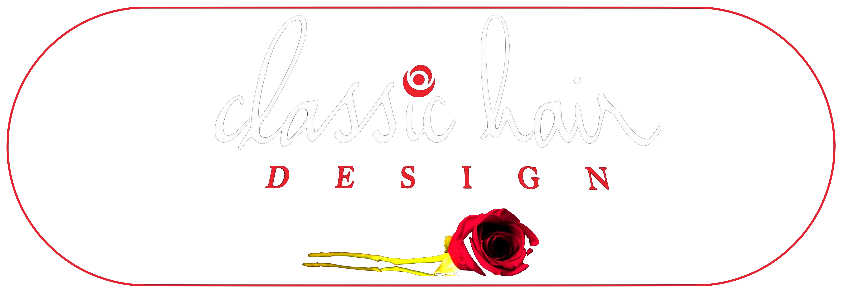
To Book an Appointment
Call or text:
9 0 5. 6 8 9. 8 5 4 9
Hit the link below to Email me for
an online consultation
Embracing the Greys: The Natural, Mature, and Sexy Trend in Hair Fashion
Not long ago, grey hair on women under 60 was almost unheard of. While men with grey hair were celebrated for their distinguished, mature appearance, women often faced outdated stereotypes, being labelled "old" or "past their prime" as silver strands appeared. But times have changed! Today, grey hair has become a symbol of confidence, allure, and timeless beauty.
How Did the Grey Hair Trend Start?
The bold movement of embracing natural grey hair gained momentum during the COVID-19 pandemic. With salons closed, many women allowed their grey roots to grow out, and as their natural grey, silver or white emerged, they embraced it with pride and confidence.
However, the shift began even before the pandemic. Younger generations started experimenting with grey tones—ranging from platinum white to smoky silver highlights—making grey a sought-after fashion statement.
This trend inspired women who had been concealing their greys with dye to stop and join the "grey fan club." Women in their mid-30s and older began showcasing their natural grey locks proudly. Some even enhanced their look with darker bold grey streaks, while others worked with stylists to foil and blend back in their natural shade for a more subtle appearance. Simply put, grey, white, and silver hair is now the new sexy! Wow, time has changed.
Grey Blending: The Art of a Seamless Transition What is grey blending?
This technique is perfect for those who aren’t ready to go fully grey but want a natural transition. Grey blending is a method that uses highlights and lowlights to seamlessly blend with your natural hair color. Unlike traditional all-over coloring, which creates a harsh regrowth line, grey blending grows out with soft, vertical lines instead of a stark horizontal band. This happens because your natural greys or whites reflect and blend with the added tones, creating a soft, diffused effect. The result is a low-maintenance look that can last for months before needing a touch-up.
In this blog, I also explore other grey blending options, like incorporating different shades of grey for dimension or transitioning back to your natural grey from dyed hair. Or, skip the details and check out the before-and-after photos of clients who have transformed, along with the techniques I used to get them there!
Embracing Grey—Where to Start?
Before beginning the transition to grey, I always start with a consultation to understand my client’s vision. Some know exactly what they want, while others give me full creative freedom to craft a look that suits them best. But if you're unsure how you want to embrace your grey, this blog covers everything you need to know—whether you're blending, growing out dye, or restoring your natural grey by removing colour. You'll also find details on different types of grey and how to enhance them with customized techniques and precise colour formulations. At the bottom of this blog, you’ll see before-and-after photos of real clients who have gone through their own grey transformations. From seamless, natural blends to bold foils and complementary tones, these looks celebrate and enhance grey hair beautifully. Don’t miss these inspiring transformations—you might just find the perfect approach for your own journey!
Finding the Right Shade of Grey That Suits You
Although this is a big trend, not everyone’s greys naturally complement them. How can you tell if your natural grey suits you? Could letting it all grow out make you look older, or could it highlight your natural beauty?
As a professional hairstylist, I’ve worked with countless shades of grey—and yes, there are many! Just as there are various tones of brown, there are greys with undertones that could either complement or clash with your skin tone. Some clients discover breathtakingly beautiful natural silvers or whites, while others find that their greys make them feel drab and unflattering.
Matching your unique skin tone with the right blend of grey or silver is an art—and one I love helping clients achieve!
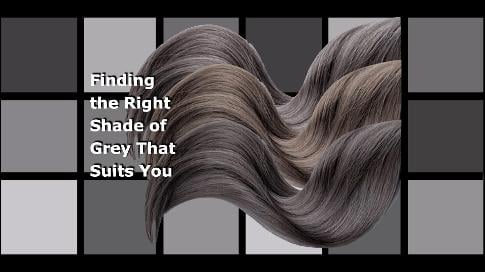
Transitioning from Dye to Grey: The Challenges
Transitioning from dyed hair to natural grey can be tricky. Some processes can be completed in one sitting, while others may take 3–6 months or longer, depending on the level of dye, your hair length, and hair type, whether fine, medium or coarse.
Steps to Begin the Process: Some clients may come to me having already fully transitioned back to their natural grey hair and might be looking to enhance or change up their look with an array of colours added in for dimension and style. Others may need help starting the process of transitioning from dyed hair to natural grey. Here are a few steps you may need:
- Assess Your Natural Grey Pattern
Begin by letting a few inches of your natural grey grow out. This helps reveal your unique grey pattern, allowing me to determine the best approach to either enhance or blend it seamlessly. - Discuss Your Goals
During a consultation, we’ll discuss whether you want a gradual, gentle transition, a complete colour restoration, or simply a way to add dimension or sparkle to your natural greys. - Choose the Right Technique
Depending on your hair type, lifestyle, and personal style, we’ll explore options such as highlights, lowlights, or creative colour blends to enhance your natural grey while ensuring the result is flattering and easy to maintain.
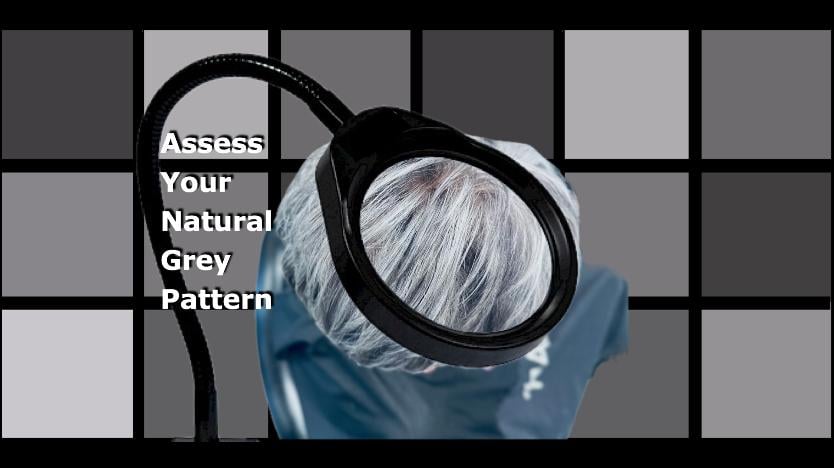
Transition and the Methods I may use.
Whether you’re enhancing what you already have or just beginning the journey to embrace your natural hair, here are some methods to get you started.
Slow Transition:
Slow transition with demi or semi-permanent colour can be a great option for clients who prefer a gradual shift. I recommend applying demi- or semi-permanent colour to the roots every 4–6 weeks. Over time, the colour fades naturally, avoiding harsh lines, and allowing the natural grey to blend in seamlessly.
Which one is best for you? demi-permanent colour works best for lighter hair as it lasts longer and uses a low volume of peroxide for a subtle lift, helping deposit colour without altering the hair's core structure. Semi-permanent colour is ideal for darker hair, requiring no peroxide. It adheres to the cuticle layers and fades naturally without harsh lines. As the dyed sections grow out and lighten over time, I adjust the formula to blend the dye ends with the natural regrowth. Depending on the hair's length, this process can take several months to a year but offers a gentle way to transition without a dramatic change or long-term commitment.
Enhance or Add Dimension:
For those already at their natural state but unsatisfied with how it looks, enhancing or adding dimension can make a significant difference. This could involve foiled-in colours, darker slates of grey, or lighter foils of white toned to silver to complement and brighten the hair. Sometimes, reintroducing some of your natural pre-grey colour through foiling or adding two complementary shades can make an incredible impact. Options include highlights or streaks of white, silver, or slate grey, incorporating lowlights of grey into white to mimic natural salt-and-pepper patterns, or creatively blending light and dark foils for a bold, stylish appearance.
Eliminating All Over Colour and Restoring the Hair Back to Natural State:
This method if for clients with all-over dyed hair who want to remove the colour entirely. It's a detailed process that involves using a colour remover (a mix of bleach and conditioner) applied in foil panels across the hair. Depending on the depth of the dye and the hair's length and textured, this can either be accomplished in one session lasting 3–6 hours or may require multiple visits over a few months for more challenging cases. Once the dyed colour has been eliminated , I will evaluate the overall look and decide on one or two methods to refine for the best results.
There are countless creative ways to blend, enhance, or even reinvent your greys. These are just the commonly known methods—your perfect solution awaits you at your appointment.
Skin Tone and Grey Hair: The Key to a Youthful Look
Your skin tone plays a critical role in achieving a youthful, harmonious look with either your natural grey hair or grey tones added to complement your complexion. This isn’t about makeup or clothing—that’s another conversation. In hair colouring, it’s about matching warm or cool tones for the perfect balance. Matching the right tone is essential for helping clients love their natural grey hair.
One scenario: Someone with completely white hair can look absolutely stunning when paired with the right skin tone, especially if enhanced with purple or blue shampoos to create a luminous "Norwegian blonde" effect. On the other hand, the same hair can appear drab, aged, or washed out when matched with the wrong skin tone. This is where re-inventing colour formulations into the greys can make a significant difference in achieving a fabulous, flattering look.
Different Types of Skin Tones
Very Light Skin with Peachy or Red Undertones
If your hair is naturally all white or light grey, this may not be complementary to your skin tone and can sometimes wash you out, making you appear older. Foils of a suitable dark grey throughout can be youthful and stunning. Additionally, adding a few neutral-toned lowlights can soften the overall look, creating a more flattering and youthful finish. These combinations don’t look aged—they can take years off your overall appearance. These are just a few options among countless techniques.
Medium, Brownish, or Olive Complexion with Golden Undertones
Most shades of grey work beautifully with these skin tones, and some may not need to do anything to their hair. For those wanting a bit more flair, adding streaks of silver or purple-hued greys can create depth and sparkle. This combination gives a stunning, polished, and chic appearance.
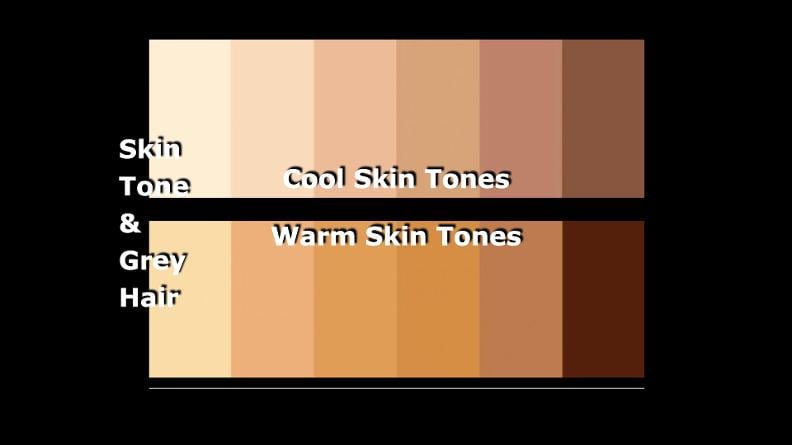
Grey Done Right: Confidence in Every Strand
Restoring or enhancing grey hair isn’t just about colour—it’s about reflecting your personality and style. Whether you prefer a natural, subtle transition or a bold, creative statement, grey is no longer a colour to hide—it’s a colour to celebrate!
Different Natural Shades of Grey and White
- White-Grey: Cloud: This shade occurs when all natural pigment is lost from the hair, resulting in a cloud-white appearance with a subtle hint of grey and no dark undertones.
- Yellow-White/Grey: Typically starting as white-grey hair, this shade takes on a yellowish tint due to environmental factors like air pollution, hard water, or smoking.
- Slate Grey: A deep, cool grey with darker undertones that resemble the colour of natural slate stone. This shade often appears in individuals who naturally had darker hair.
- Silver Grey: A vibrant metallic grey created by a blend of grey (with more grey than white) and threads of white that reflect light. This combination gives the hair a soft, shimmering, metallic sheen.
- Salt & Pepper Grey: A natural mix of light grey and darker shades, creating a speckled or streaked effect. This pattern offers a textured, balanced look that highlights the contrast between light and dark strands.
- Grey Streaking: Striking accents of pronounced streaks of white, grey, or silver naturally mingled with your original hair colour. These natural grey highlights add depth and texture, often framing the face beautifully and enhancing the hair’s overall character.

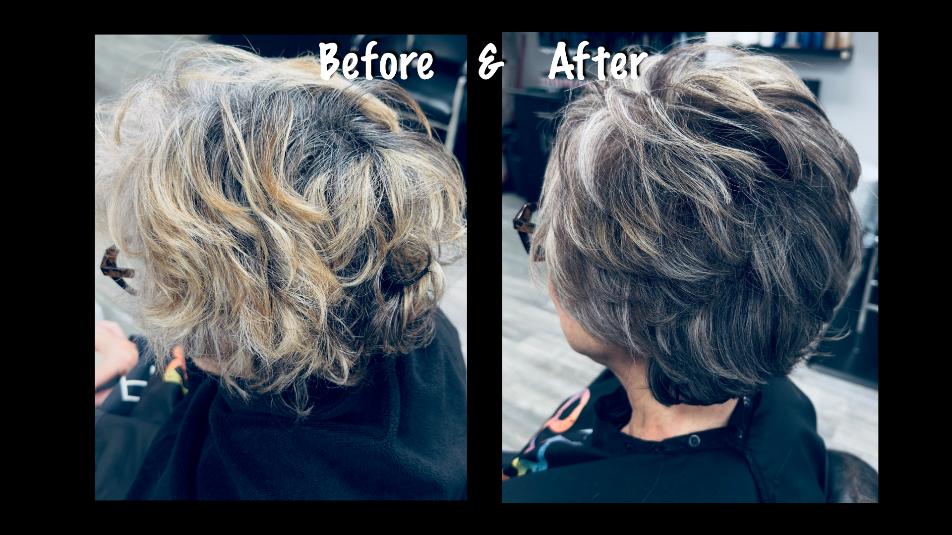
Steel/Silver Grey: A striking cool tone, this shade captures the brilliance and sleekness of polished steel or silver. Its high-shine finish reflects light beautifully, emphasizing the cool tones in natural grey hair. Steel grey adds a touch of elegance and refinement, perfect for creating a bold yet polished appearance.
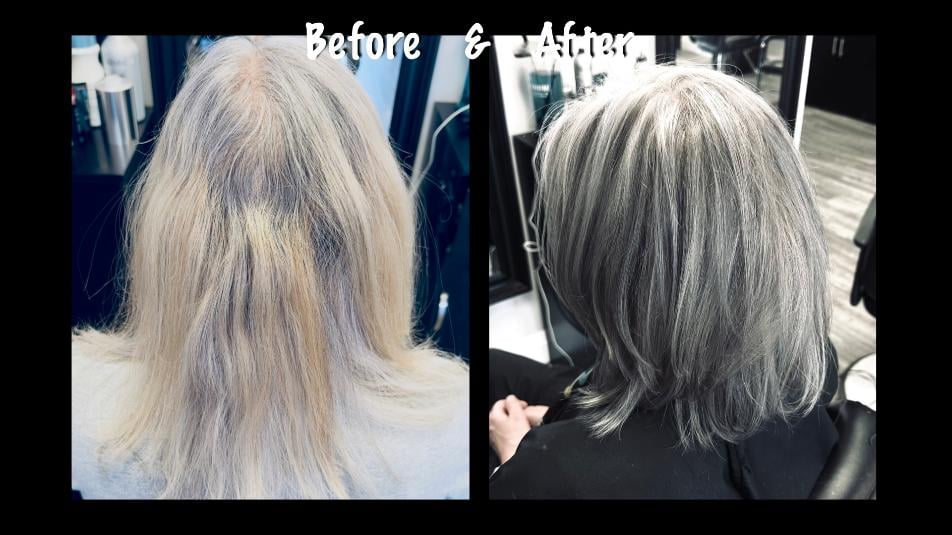
Smoky Grey: This cool-toned shade features soft, light smoke grey with a touch of charcoal. Smoky grey is an excellent choice for toning away unnatural yellow hues in cloud-white or yellow-grey hair when applied all over. It can also be added through foils to lighter silver or cloud-white hair, creating velvety, understated depth. Smoky grey breaks up the white haze, giving the hair a shadowy effect that looks youthful and modern.
Check Out These Stunning Before-and-After Pictures
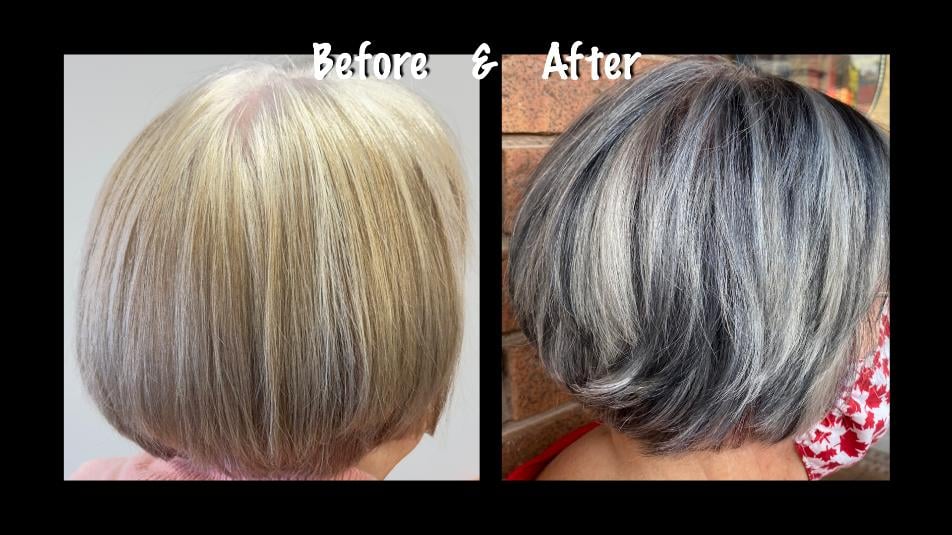
Blue-Grey: Cool and icy, this shade introduces a subtle blue undertone to grey, resulting in a crisp, frosty effect. Blue-grey works best in lighter grey hair, enhancing its natural brightness. When added through foils, it creates pops of colour that stand out against white strands, giving the hair a streaked appearance. This shade pairs wonderfully with pale skin tones for an ethereal look and offers striking contrast on olive or darker skin tones.
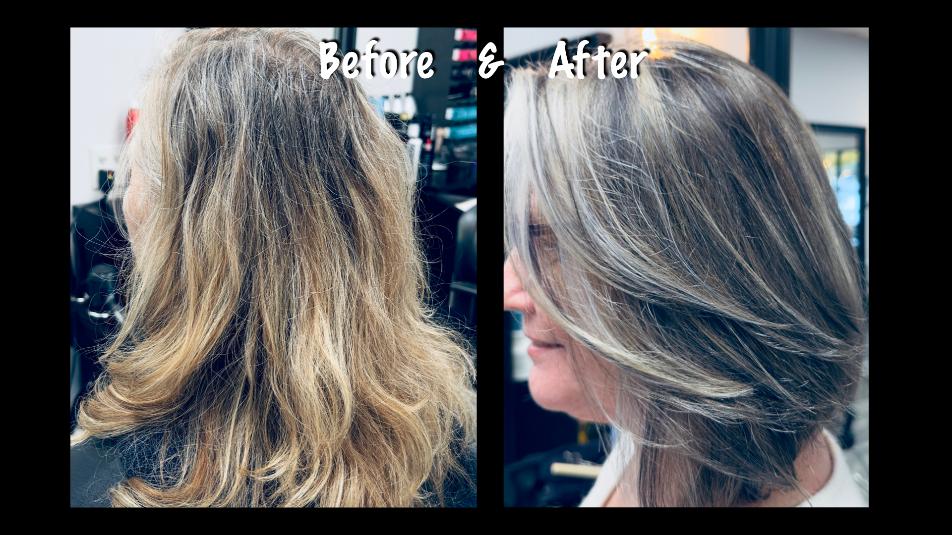
Ash Grey: A cool-toned grey, ash grey has a soft, muted appearance that harmonizes beautifully with existing hair colour. Its neutral undertone makes it versatile and universally flattering, adding understated dimension without overpowering the natural base colour. Ash grey is particularly complementary to lighter grey hair and suits pale skin tones seamlessly.
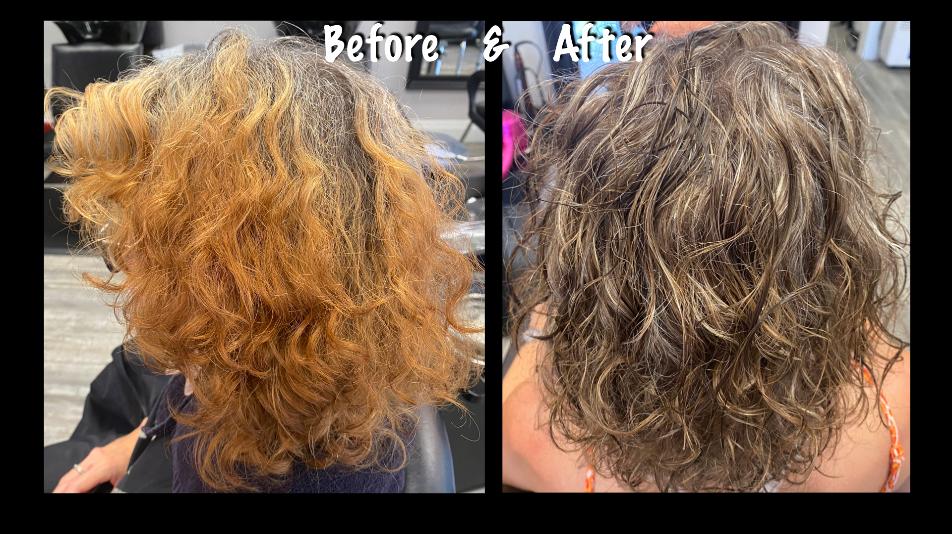
Beige-Grey (Warm): A warm, soft grey with beige undertones, this shade offers a natural and understated effect. Beige-grey works well on warmer skin tones, softening the overall appearance and blending seamlessly into hair that naturally transitions from darker warm shades. It adds subtle warmth and dimension without overpowering the natural grey.
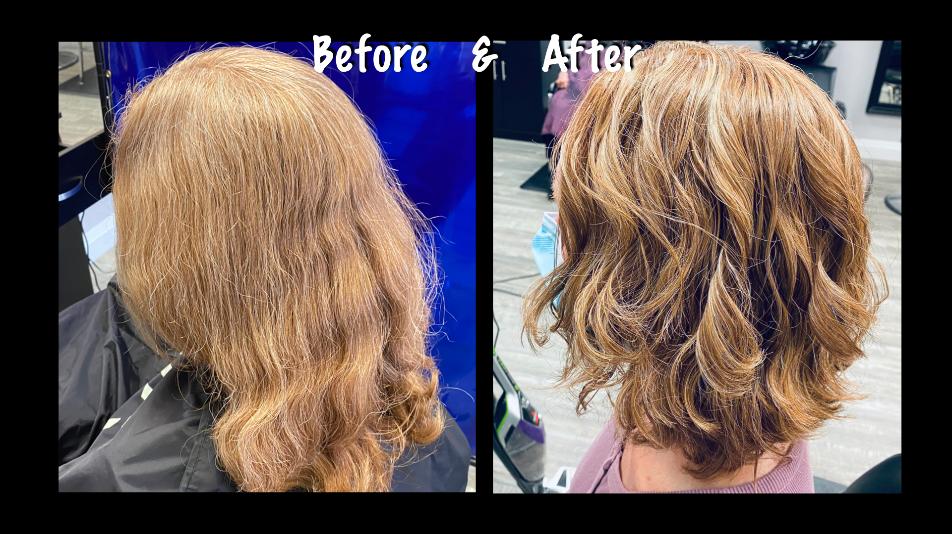
The Most Challenging Hair to Transform: Redheads and gingers—these unique hair colours present distinct challenges when transitioning back to grey or, if already grey, finding the right tones to enhance their natural beauty. Warm shades, such as rich browns and mahogany hues, paired with a combination of lowlights and highlights, can counteract a flat or mousy appearance, adding depth and vibrancy to the hair.
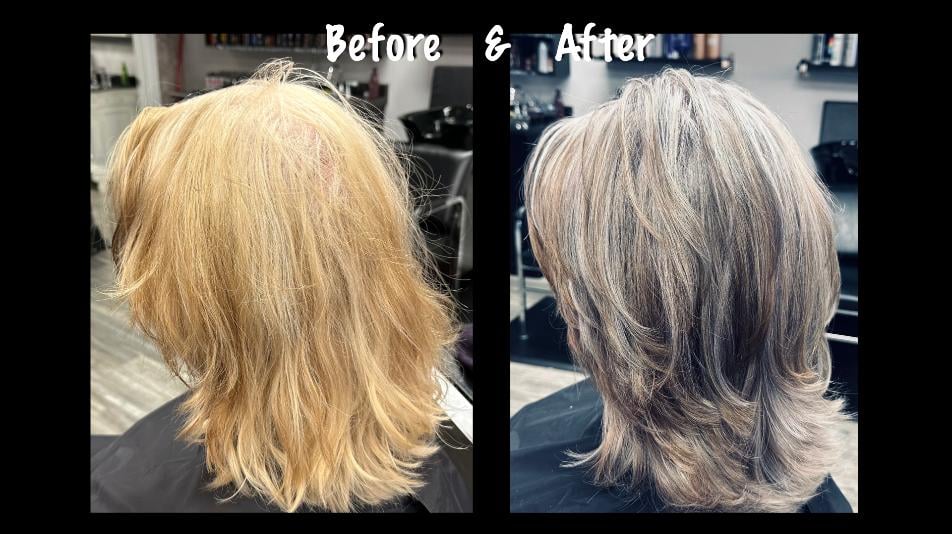
Golden Grey (Warm): This warm-toned shade combines grey with golden undertones for a luminous and radiant finish. Golden grey is ideal for individuals with warm or olive skin tones, as it enhances warmth and brings a touch of brightness to the hair. It can be applied as streaks or highlights to break up cooler grey shades and add warmth to the overall look.
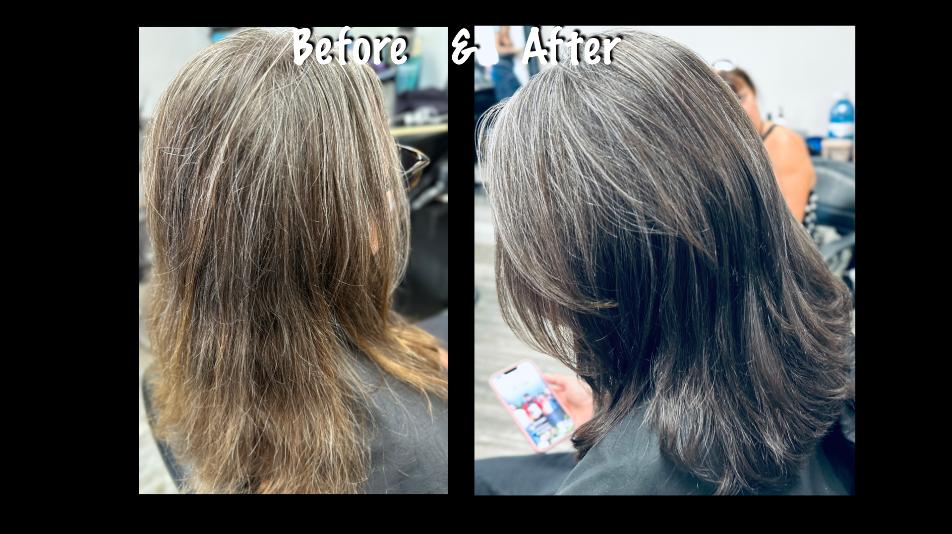
Natural Grey Match: This cool-toned shade features regrowth with grey evenly sprinkled throughout dark brown hair. The grown-out colour had a mix of dark dye with warm, brassy undertones. A simple colour match formulation was applied to the previously coloured sections to balance and blend with the natural grey, eliminating the gold tones. Cooler grey/violet shades were added to complete the look.
516 Plains Rd E, Burlington ON L7T 2E1 ( located inside Silk Hair Salon) 905 689 8549
Classic Hair Design is a beauty service located in Burlington, proudly serving the communities of Burlington, Waterdown, Dundas, and Ancaster for over 35 years.
With over 35 years of experience, hairstylist Abby Birbari offers advanced haircutting for ladies and men. Specializing in colour correction, colour makeovers, foil highlights, ombre highlights, balayage highlights, shadow highlights, silver highlights, grey blending, and hand-painted highlights. A qualified perm technician specializing in body wave perms, spiral perms, beach wave perms, multi-textured perms, pyramid perms, piggyback perms, and ombre/balayage perms. Curly hair specialist, specializing in curly haircut and style, and permanent hair straightening.